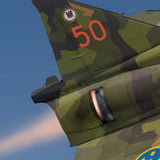The Saab 37 Viggen had a unique delta-canard wing configuration and had the ability to operate in austere conditions. The name "Viggen" has two meanings; the first referring to åskvigg or "thunderbolt" created by the lightning strikes of the Norse god Thor when wielding the war hammer, Mjölnir. Vigg is also the Swedish name for a small diving, tufted duck native to Sweden.
The Viggen utilized a license-built version of the Pratt & Whitney JT8D turbofan engine with a large afterburner can attached to the end of the engine. The engine installation incorporated thrust reverser petals housed inside the exhaust nozzle as well as with perimeter bypass vanes. This enabled the Viggen to roll in reverse on the ground. It had outstanding short take-off performance being able to get airborne in less than 1,500 feet and was very agile at low speeds immediately after liftoff.
It was amongst the most advanced combat aircraft in Europe at the time. The avionics package was the first of its kind in the world and featured an airborne digital central computer with integrated circuits. From the very start, the aircraft was designed as an integrated weapon system to operated in conjunction with Sweden's STRIL-6 national electronic air defense system.
JA 37 Viggens were successful in performing hot intercepts being able to achieve radar lock against the SR-71 Blackbirds although the Blackbirds always flew the same "Baltic Express" route and flights were announced in advance which made interceptions considerably easier. The Viggen is the only aircraft to get an acknowledged radar lock on the SR-71.
The Viggen was eventually replaced by the JAS 39 Gripen. The last Viggen flights took place in 2007.








